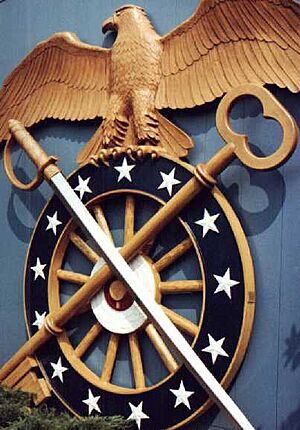U.S. Army Quartermaster Museum facts for kids

Quartermaster Branch Insignia on the side of the museum
|
|
| Established | 1957 |
|---|---|
| Location | 1201 22nd Street, Bldg. 5218 Fort Gregg-Adams, Virginia |
| Collections |
|
| Visitors | 70,000 |
The United States Army Quartermaster Museum is a special place in Fort Gregg-Adams, Virginia. It is a museum that collects and shows the history of the Quartermaster Corps. This group helps the U.S. Army with supplies, food, and equipment. The Quartermaster Corps started way back in 1775.
The museum has over 24,000 items in its collection. It also helps teach history to soldiers at the Quartermaster Center and School. More than 16,000 soldiers learn here each year.
Contents
Museum History: How It Started
The idea for the museum began in 1953. The Quartermaster School at Fort Gregg-Adams started collecting old uniforms. They used these uniforms to teach students about fitting and sizing clothes.
In 1954, two old buildings from World War II were opened. These buildings held the uniforms. People often called this popular classroom display the "museum."
Official Opening and Growth
The museum officially opened in February 1957. The uniforms and other donated items became the first parts of its collection. Many items came from old Quartermaster supply centers. These centers were in places like Philadelphia, Pennsylvania, and Jeffersonville, Indiana.
The main museum building was finished in June 1963. It is 20,000 square feet, which is a very large space. Money for building it came from private donations and loans. Once it was built, the building was given to the U.S. Government.
In 1976, the museum building was named after Brigadier General John A. Spencer Jr. He was very important in helping to create the museum.
The Army Quartermaster Foundation, Inc. has continued to raise money. This money has helped the museum grow and add more sections.
New Additions to the Museum
In October 1993, the museum added a large auditorium. This room can seat 100 people. It was named after Major General Robert M. Littlejohn. He was the Quartermaster for Europe during World War II. He also strongly supported the museum.
A research and learning center was completed in June 1998. It was named for Major General Joseph E. Peklik. He worked hard to raise money for this new part. This area holds the museum's curator, a library, and places to store old records. It also has a lab for taking care of the collection.
Outside the museum, you can see a huge symbol. It is a three-dimensional sign of the Quartermaster branch. Many visitors take group photos in front of this famous symbol.
Amazing Items at the Museum
The Quartermaster Museum has several very special items. These are like "National Treasures" because they are so important.
- General Patton's World War II Jeep. This Jeep was used by General George S. Patton during World War II in Europe. It was changed to fit his unique style. It even has special air-horns on the hood to announce his arrival!
- General Grant's Civil War Saddle. This saddle was used by General Ulysses S. Grant. He rode it from July 1862 until the end of the Civil War in April 1865. Grant gave the saddle to a staff member in 1869. It was at the Smithsonian Institution for over 70 years. It came to the Quartermaster Museum in 1968. Many people think it is one of the most valuable items in the Army's museum system.
- General Grant's Civil War Wagon. The museum also displays an 1861 Army ambulance. It is believed that Grant used this wagon to carry his bags during the Petersburg Campaign. After the war, it was stored in different places before coming to the museum.
- President Franklin Pierce's Saddle. This saddle has silver decorations. It dates from the late 1840s. President Pierce used it when he was a military leader in the war with Mexico.
- General Eisenhower's Office Van. General Dwight D. Eisenhower used this vehicle during World War II. He was the top commander for the Allied forces in Europe. This large semi-trailer was his mobile living space and office. It has wood walls, a bed, a closet, and even a shower and toilet.
- The First 50-Star Flag. This flag was given to President Eisenhower in 1960. It showed that Hawaii had become the 50th state.
- Presidential Flags. The museum has one of the largest collections of flags used by U.S. Presidents. These include flags from Presidents Taft, Wilson, Harding, Truman, Eisenhower, Theodore Roosevelt, and Franklin Roosevelt.
See also
- Military supply
- Quartermaster
- Quartermaster Center and School
- Quartermaster Corps (United States Army)
- Quartermaster general
- All pages beginning with Quartermaster

